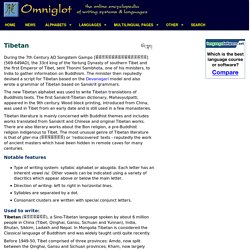

Tibetan buddhist symbols and artifacts in figure for five wonderful vector. Tibetan alphabet. The Tibetan alphabet is an abugida of Indic origin used to write the Tibetan language as well as the Dzongkha language, Denzongkha, Ladakhi language and sometimes the Balti language. The printed form of the alphabet is called uchen script (Tibetan: དབུ་ཅན་, Wylie: dbu-can; "with a head") while the hand-written cursive form used in everyday writing is called umê (Tibetan: དབུ་མེད་, Wylie: dbu-med; "headless"). The alphabet is very closely linked to a broad ethnic Tibetan identity. Besides Tibet, it has also been used for Tibetan languages in Bhutan, India, Nepal, and Pakistan.[1] The Tibetan alphabet is ancestral to the Limbu alphabet, the Lepcha alphabet,[2] and the multilingual 'Phags-pa script.[2] The Tibetan alphabet is romanized in a variety of ways.[3] This article employs the Wylie transliteration system.
History[edit] Three orthographic standardizations were developed. Description[edit] The Tibetan alphabet has thirty basic letters, sometimes known as "radicals", for consonants.[2] Tibetan alphabet, pronunciation and language. During the 7th Century AD Songstem Gampo [སྲོང་བཙན་སྒམ་པོ་] (569-649AD), the 33rd king of the Yarlung Dynasty of southern Tibet and the first Emperor of Tibet, sent Thonmi Sambhota, one of his ministers, to India to gather information on Buddhism.

The minister then reputedly devised a script for Tibetan based on the Devanagari model and also wrote a grammar of Tibetan based on Sanskrit grammars. The new Tibetan alphabet was used to write Tibetan translations of Buddhists texts. The first Sanskrit-Tibetan dictionary, Mahavyutpatti, appeared in the 9th century. Wood block printing, introduced from China, was used in Tibet from an early date and is still used in a few monasteries. Tibetan literature is mainly concerned with Buddhist themes and includes works translated from Sanskrit and Chinese and original Tibetan works. Notable features Type of writing system: syllabic alphabet or abugida.
Used to write: Tibetan. Tibetan is one of the oldest Sino-Tibetan language to be recorded.

The earliest Tibetan inscriptions date from 7th to 8th century CE in what is called the dbu can (which translates into "with a head") script, which also appeared on manuscripts from around 11th CE and remained until the modern day in the form of printed Tibetan text. Another script tradition, the dbu med ("without a head", "acephalous"), appearing first around the 12th century CE. The main difference between the two script traditions is that the dbu can script has the top line (hence the name "with a head") and less cursive than the dbu med script. The origin of the Tibetan script is rather obscure. Tibetan Buddhist tradition states that it was created by Minister Thon mi Sambhota in northeastern India by order of the Tibetan king Srong btsan sgam po. The following is a list of all the signs in the dbu can script. Retroflex (apico-palatal) consonants (/t/ and /d/) occur only in loanwords from Sanskrit.
Elements of the Tibetan writing system - chrisfynn2. How to write the Tibetan script - chrisfynn2. Tibetan block-letter script (gzab ma), generally known as the headed, dbu-can [pron: "u-chen"] script, is traditionally written using a hand-made bamboo or reed pen cut at an angle. A broad steel nibbed italic calligraphy pen may be used instead. Steel nibbed calligraphic pens designed for left-handed writers of Roman italic script are slanted at a suitable angle for a right-handed person to use when writing the Tibetan dbu-chan script. To produce the proper thickness of horizontal strokes, the width of the pen nib should be about 1/12th the height of the letter ka. The pen is held between the thumb and index fingers so that, as you write, the pen may be rotated to obtain the proper tansition between thick and thin strokes.
The other fingers are drawn up into a fist, though some people extend the little finger to form a surface for the hand to rest on and provide greater stability. Vowels and Consonants (Ali Kali)